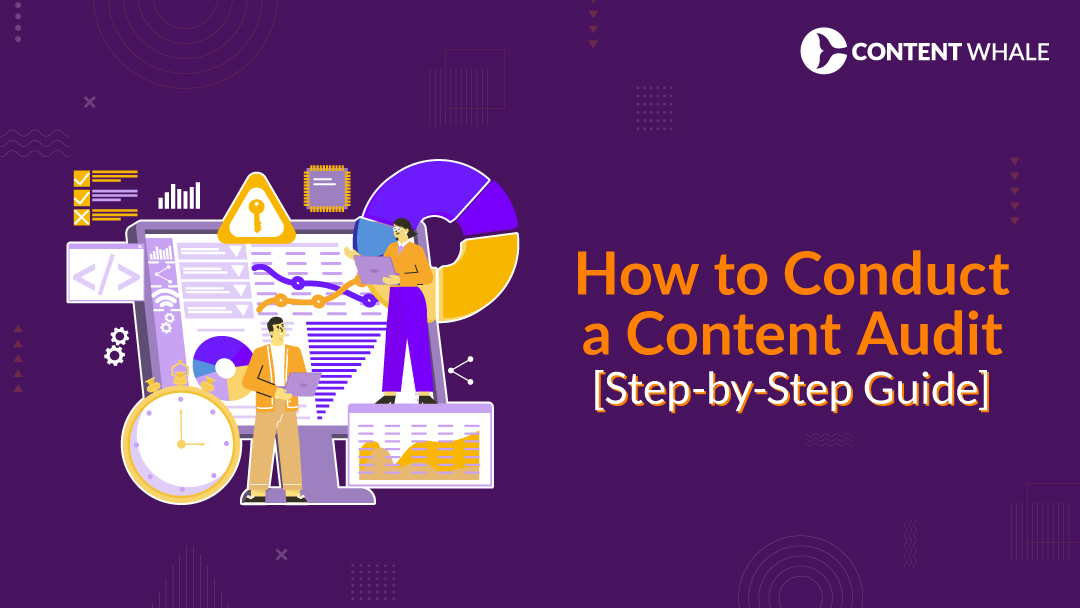Quick Summary
Conducting a content audit is essential for improving your SEO. This step-by-step guide explains how to perform a content audit, the tools you’ll need, and how to implement your findings to boost your content strategy. By understanding how to conduct a content audit, you can enhance your site’s performance, ensuring it meets user needs and stands out in search engine rankings. With the right approach and tools, such as Google Analytics and SEMrush, a content audit can uncover valuable insights that drive your overall SEO audit efforts.
A content audit is a thorough evaluation of all the content on your website to determine its performance, quality, and relevance.
This process is essential for SEO as it helps you identify which pieces of content are working well and which need improvement.
Regularly conducting a content audit allows you to stay ahead in the competitive digital space by ensuring your content remains fresh and effective.
The benefits of a content audit for SEO are numerous. It helps in identifying content gaps, removing duplicate content, and optimizing underperforming pages.
By doing so, you enhance your site’s visibility on search engines, which can lead to increased organic traffic and better engagement from your audience.
Moreover, a well-executed content audit can significantly improve user experience by ensuring that visitors find valuable and relevant information quickly and easily.
In this blog, we will cover how to conduct a content audit step-by-step. We’ll discuss the tools you need, the process of collecting and analyzing your content, and how to implement the findings to boost your content strategy.
Whether you’re a seasoned marketer or new to SEO, this guide will equip you with the knowledge to perform an effective content audit and improve your site’s performance.
Understanding the Importance of a Content Audit

A content audit is a vital process for maintaining the health and effectiveness of your website’s content.
This systematic review helps you understand what content you have, how it is performing, and where improvements can be made.
Here’s why content audits are essential for SEO and overall content strategy.
1. Improve SEO Performance
A well-executed SEO audit identifies issues such as duplicate content, broken links, and pages with low engagement.
These problems can significantly hinder your search engine rankings. By addressing these issues through a content audit, you can enhance your site’s visibility on search engines, leading to increased organic traffic.
For instance, removing or updating low-performing content ensures that search engines prioritize your best content, improving overall SEO performance.
2. Identify Content Gaps and Opportunities
A content audit helps you pinpoint gaps in your existing content. By identifying these gaps, you can create new content that fills these voids, ensuring that your website covers all relevant topics your audience is interested in.
This can help you stay competitive and meet the evolving needs of your audience.
Additionally, identifying high-performing content can provide insights into what topics resonate most with your audience, guiding your future content strategy.
3. Enhance User Experience
Improving the user experience is another critical benefit of conducting a content audit.
By evaluating metrics such as bounce rates, time on page, and pages per session, you can determine which content keeps users engaged and which does not.
Enhancing content that performs poorly and promoting high-performing content can make your site more user-friendly and engaging.
This leads to longer visit durations and higher engagement rates, which positively affect SEO.
4. Streamline Content Management
A content audit is also about maintaining a clean and efficient content inventory. Over time, websites can accumulate outdated or redundant content that clutters your site and confuses visitors.
Regular audits help you prune unnecessary content and keep your site streamlined and relevant. This not only improves user navigation but also makes it easier to manage and update your content going forward.
5. Align Content with Business Goals
Finally, a content audit ensures that your content aligns with your current business goals and marketing strategies.
Whether your focus is on driving sales, increasing brand awareness, or providing valuable information, regular audits help ensure that your content supports these objectives.
This alignment is crucial for maximizing the return on investment from your content marketing efforts.
In summary, a content audit is indispensable for optimizing your website’s performance, enhancing user experience, and ensuring your content strategy remains effective and aligned with your business goals.
Preparing for a Content Audit

Before starting a content audit, it’s crucial to gather the right tools and resources to ensure a comprehensive analysis. Here are the key steps and tools you’ll need for effective preparation:
1. Essential Tools and Resources:
Several tools can make the content audit process more efficient and thorough. Here are some of the most recommended ones:
i) Google Analytics
This tool is indispensable for tracking and analyzing website traffic. It provides insights into page views, bounce rates, and user behavior, helping you understand which content performs well and which doesn’t.
ii) Google Search Console
It helps you monitor your site’s search performance and identify issues like crawl errors and mobile usability problems. It also provides data on search queries and pages that receive the most clicks.
iii) SEMrush
A powerful tool for detailed SEO analysis. It offers features like keyword tracking, backlink analysis, and a comprehensive site audit that identifies issues affecting your site’s performance.
iv) Screaming Frog
This tool crawls your website to find broken links, audit redirects, analyze page titles and metadata, and discover duplicate content. It’s excellent for a detailed SEO audit.
2. Preparing Your Data and Content:
Before conducting a content audit, organize your data and content to streamline the process:
i) Content Inventory
Create an inventory of all your content. This can be done using a spreadsheet where you list URLs, titles, publication dates, and performance metrics such as page views and engagement rates.
ii) Categorization
Group your content by type (e.g., blog posts, product pages, landing pages) and by topic. This will help you see which areas are performing well and which need improvement.
iii) Performance Metrics
Collect performance data for each piece of content. Key metrics include organic traffic, bounce rate, average time on page, social shares, and backlinks. These metrics will help you assess the effectiveness of your content.
3. Setting Clear Goals and Objectives
Define what you aim to achieve with your content audit. Clear goals will guide your audit process and help you measure success:
i) SEO Improvement
Identify opportunities to enhance search engine rankings by optimizing underperforming content and removing or updating outdated information.
ii) Content Quality
Ensure all content meets quality standards, is relevant to your audience, and aligns with your brand’s messaging.
iii) User Engagement
Aim to improve user engagement by making your content more appealing and easier to navigate.
By utilizing these tools and following these preparatory steps, you’ll be well-equipped to conduct a thorough and effective content audit.
This preparation will ensure that your audit is comprehensive and that the insights you gain will significantly enhance your content strategy.
Step-by-Step Guide on How to Conduct a Content Audit

Conducting a content audit involves several critical steps that help you evaluate and optimize your website’s content for better performance and SEO. Here’s a detailed guide on how to conduct a content audit effectively:
1. Collect All Content URLs
Start by gathering all the URLs of the content you want to audit. This can be done using tools like SEMrush, Screaming Frog, or a sitemap generator.
These tools can help you quickly compile a list of URLs and their associated metrics based on your sitemap.
2. Analyze Content Performance Metrics
Once you have your list of URLs, use Google Analytics and Google Search Console to gather data on key performance metrics.
Look at metrics such as page views, bounce rates, average session duration, and organic traffic.
These insights will help you understand how each piece of content is performing in terms of user engagement and SEO.
3. Evaluate Content Quality and Relevance
Assess the quality and relevance of each piece of content. This involves checking for outdated information, poor readability, and lack of engagement.
Tools like Grammarly can help improve readability, while SEMrush can assist in evaluating SEO performance.
Look for content that no longer aligns with your current content strategy and consider updating or removing it.
4. Identify Content Gaps and Redundancies
Examine your content inventory to identify gaps where new content could add value and areas where content overlaps or is redundant.
This step helps you discover opportunities for creating new content that addresses unmet needs of your audience and removes content that duplicates efforts.
Using keyword research tools can also help identify gaps in your content that need to be filled.
5. Prioritize Content for Updates or Removal
Based on your analysis, prioritize which content needs to be updated, consolidated, or removed.
High-priority updates might include content that performs well but contains outdated information or has high engagement but needs better SEO optimization.
Use a scoring system to rank content based on factors such as traffic, engagement, and relevance to your current content strategy.
6. Implementing the Audit Findings
After categorizing your content, create a detailed action plan. This should include specific tasks like updating metadata, adding internal links, rewriting outdated sections, or even deleting content that no longer serves a purpose.
Assign tasks to team members and set deadlines to ensure timely execution. Tools like Asana or Trello can help manage these tasks effectively.
7. Tips for Using Tools
Utilize tools like Google Analytics for traffic and engagement metrics, SEMrush for SEO analysis, and Screaming Frog for a comprehensive site crawl.
These tools can provide in-depth insights and make the auditing process more efficient.
Regularly updating and maintaining your content based on these insights will help improve your site’s performance and user engagement.
By following these steps, you can ensure that your content audit is thorough and effective, leading to improved SEO and a more strategic approach to your content management.
Regular content audits are crucial for keeping your content relevant and aligned with your business goals.
Implementing Findings from Your Content Audit

After completing a content audit, the next crucial step is to implement the findings effectively. Here’s how you can translate the insights from your audit into actionable strategies:
1. Update Existing Content
Start by updating content that is outdated or underperforming. Focus on improving the quality, relevance, and SEO of these pages.
Ensure the content is aligned with current SEO audit practices by optimizing for keywords, updating metadata, and enhancing readability.
Adding new data, images, or insights can make old content more valuable and engaging.
2. Create a Content Plan Based on Audit Results
Develop a content plan that addresses the gaps identified during the audit.
This might include creating new content on high-potential topics or expanding existing content to cover more depth.
Use tools like Google Analytics and SEMrush to identify high-performing content and replicate its success across other pages.
3. Remove or Consolidate Redundant Content
Eliminate content that no longer serves a purpose or consolidates similar content pieces to avoid duplication.
For example, if you have multiple articles covering the same topic, merge them into a single comprehensive guide.
This not only improves the user experience but also strengthens your site’s SEO by concentrating link equity on fewer, higher-quality pages.
4. Optimize Internal Linking
Enhance your internal linking structure to improve site navigation and distribute link equity effectively.
Link high-authority pages to underperforming ones to boost their visibility and performance.
This strategy can also help search engines crawl your site more efficiently, improving overall SEO.
5. Monitor and Adjust
After implementing changes, continuously monitor the performance of your updated content.
Use KPIs such as organic traffic, bounce rate, and conversion rate to measure success. Regularly review analytics to identify new areas for improvement and adjust your strategy accordingly.
By systematically updating, removing, and optimizing content based on your audit findings, you can significantly enhance your content strategy and achieve better SEO results.
This ongoing process ensures your content remains relevant, valuable, and aligned with your business goals.

Regular content audits are essential for maintaining a high-performing website.
They enable you to identify and address content issues, ensuring your site remains relevant, engaging, and optimized for search engines.
By systematically analyzing your content, you can uncover valuable insights that inform your content strategy and drive better SEO results.
Conducting a content audit helps you keep your content up-to-date, discover gaps and opportunities, and enhance the user experience.
This process not only improves your site’s visibility in search engine results but also boosts user engagement and conversion rates.
Implementing the findings from your audit, such as updating outdated content, removing redundant pieces, and optimizing underperforming pages, ensures your content stays aligned with your business goals and audience needs.
Encourage your team to start a content audit today to unlock the full potential of your content.
Regular audits will keep your content fresh, relevant, and competitive in the digital space.
For further reading or consulting services, explore additional resources or contact our team, at Content Whale for personalized assistance on your next content audit!
FAQs
1. What is a content audit?
A content audit is a comprehensive evaluation of all the content on your website. This process helps you analyze the performance, quality, and relevance of your content, ensuring it aligns with your overall content strategy. By conducting a content audit, you can identify gaps, remove redundant content, and optimize underperforming pages to improve your site’s SEO and user engagement.
2. How often should I conduct a content audit?
It’s advisable to conduct a content audit at least once a year.
However, if you produce a high volume of content or operate in a rapidly changing industry, performing audits every six months can be beneficial.
Regular audits help keep your content relevant and aligned with your business goals and SEO strategy.
3. What tools are best for performing a content audit?
Several tools can assist with a content audit, including:
- Google Analytics: For tracking and analyzing website traffic.
- Google Search Console: For monitoring search performance and identifying issues.
- SEMrush: For in-depth SEO analysis and content performance metrics.
- Screaming Frog: For comprehensive site crawling and technical SEO insights.
4. Can a content audit improve my SEO?
Yes, a content audit can significantly enhance your SEO. By identifying and fixing content issues, optimizing for relevant keywords, and ensuring all content aligns with your SEO strategy, you can improve your site’s search engine rankings, increase organic traffic, and boost user engagement.
5. What are the common challenges in conducting a content audit?
Common challenges include gathering comprehensive data, accurately assessing content quality, and implementing the necessary changes effectively.
The process can be time-consuming, especially for large websites, but using tools like Google Analytics and SEMrush can streamline the audit process.





